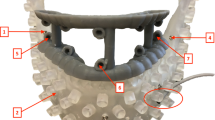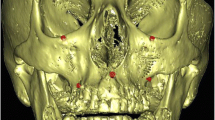Abstract
Most commonly used orthognathic surgery procedures have been used for more than 50 years following a typical planning protocol. The main aim of these procedures is to displace the maxilla or mandible (mono-maxillary approach) or both (bimaxillary approach) into another position to correct maxillofacial deformities. The planning process for bimaxillary approach is more difficult than mono-maxillary approach and requires the application of several steps to produce two splints: intermediate and final. Intermediate splints suffer from accumulated errors in the planning procedure and is the target of improvements. Even with the introduction of three-dimensional (3D) virtual planning into orthognathic surgery, differences between preoperative planning and postoperative outcome achieved have been shown with both under- or over-corrections. Splint-based techniques have to be improved by relying on splint-less techniques. Image-guided navigation systems have been introduced in 1996 in orthognathic surgery as a splint-less technique with the promise of guiding surgeons with real-time visualization of the accurate position of surgical instruments. Unfortunately, navigation systems failed to live up to the promise and can only be used as a measuring tool rather than a guiding tool.
Access this chapter
Tax calculation will be finalised at checkout
Purchases are for personal use only
Similar content being viewed by others
References
Plath T, Hoffmeister B, Neumann P, Siebert D, Tolxdorff T, Wolff K, et al. Positioning of the maxilla in orthognathic surgery using intraoperative navigation. Int J Oral Maxillofac Surg. 1999;28:62. https://doi.org/10.1016/S0901-5027(99)80839-X.
Tanaka M, Sato H, Inada T, Yaso A, Ogura H, Shirota T. Maxillary repositioning using a CAD/CAM wafer and an intraoperative navigation system for bimaxillary orthognathic surgery using segmental Le fort I osteotomy: a pilot study. J Oral Maxillofac Surg Med Pathol. 2021;33(6):581–6. https://doi.org/10.1016/j.ajoms.2021.04.003.
Bell RB. Computer planning and intraoperative navigation in orthognathic surgery. J Oral Maxillofac Surg. 2011;69(3):592–605. https://doi.org/10.1016/j.joms.2009.06.030.
Azarmehr I, Stokbro K, Bell RB, Thygesen T. Surgical navigation: a systematic review of indications, treatments, and outcomes in oral and maxillofacial surgery. J Oral Maxillofac Surg. 2017;75(9):1987–2005. https://doi.org/10.1016/j.joms.2017.01.004.
Shaheen E, Sun Y, Jacobs R, Politis C. Three-dimensional printed final occlusal splint for orthognathic surgery: design and validation. Int J Oral Maxillofac Surg. 2017;46(1):67–71.
Shaheen E, Coopman R, Jacobs R, Politis C. Optimized 3D virtually planned intermediate splints for bimaxillary orthognathic surgery: a clinical validation study in 20 patients. J Craniomaxillofacial Surg. 2018;46(9):1441–7. https://doi.org/10.1016/j.jcms.2018.05.050.
Govaerts D, Shaheen E, Coopman R, De Mol A, Sun Y, Politis C. Accuracy of Le Fort I osteotomy in bimaxillary splint-based orthognathic surgery: focus on posterior maxillary movements. Int J Oral Maxillofac Surg. 2018;47(11):1398–404. https://doi.org/10.1016/j.ijom.2018.05.008.
Mulier D, Shaheen E, Shujaat S, Fieuws S, Jacobs R, Politis C. How accurate is digital-assisted Le Fort I maxillary osteotomy? A three-dimensional perspective. Int J Oral Maxillofac Surg. 2020;49(1):69–74.
Agbaje JO, Sun Y, Lambrichts I, Politis C. Problems during orthognathic surgery resulting from errors in diagnostic wax bite. J Craniofac Surg. 2013;24(3):999–1001. http://www.ncbi.nlm.nih.gov/pubmed/23714932
Nijmeh AD, Goodger NM, Hawkes D, Edwards PJ, McGurk M. Image-guided navigation in oral and maxillofacial surgery. Br J Oral Maxillofac Surg. 2005;43(4):294–302.
Sun Y, Luebbers HT, Agbaje JO, Schepers S, Vrielinck L, Lambrichts I, et al. Validation of anatomical landmarks-based registration for image-guided surgery: an in-vitro study. J Craniomaxillofacial Surg. 2013;41(6):522–6. https://doi.org/10.1016/j.jcms.2012.11.017.
Sun Y, Luebbers HT, Agbaje JO, Lambrichts I, Politis C. The accuracy of image-guided navigation for maxillary positioning in bimaxillary surgery. J Craniofac Surg. 2014;25(3):1095–9.
Shim BK, Shin HS, Nam SM, Kim YB. Real-time navigation-assisted orthognathic surgery. J Craniofac Surg. 2013;24(1):221–5.
Chen X, Li Y, Xu L, Sun Y, Politis C, Jiang X. A real time image-guided reposition system for the loosed bone graft in orthognathic surgery. Comput Assist Surg (Abingdon). 2021;26(1):1–8.
Han JJ, Woo S-Y, Yi W-J, Hwang SJ. Robot-assisted maxillary positioning in orthognathic surgery: a feasibility and accuracy evaluation. J Clin Med. 2021;10(12):2596.
Mischkowski RA, Zinser MJ, Kübler AC, Krug B, Seifert U, Zöller JE. Application of an augmented reality tool for maxillary positioning in orthognathic surgery - a feasibility study. J Craniomaxillofacial Surg. 2006;34(8):478–83.
Wagner A, Rasse M, Millesi W, Ewers R. Virtual reality for orthognathic surgery: the augmented reality environment concept. J Oral Maxillofac Surg. 1997;55(5):456–62.
Stokbro K, Borg SW, Andersen MØ, Thygesen T. Patient-specific 3D printed plates improve stability of Le Fort 1 osteotomies in vitro. J Craniomaxillofacial Surg. 2019;47(3):394–9.
Stokbro K, Bell RB, Thygesen T. Patient-specific printed plates improve surgical accuracy in vitro. J Oral Maxillofac Surg. 2018;76(12):2647.e1–9. https://doi.org/10.1016/j.joms.2018.08.002.
Author information
Authors and Affiliations
Corresponding author
Editor information
Editors and Affiliations
Rights and permissions
Copyright information
© 2022 The Author(s), under exclusive license to Springer Nature Switzerland AG
About this chapter
Cite this chapter
Politis, C., Sun, Y., Lei, T., Shaheen, E. (2022). Navigation in Orthognathic Surgery. In: Parhiz, S.A., James, J.N., Ghasemi, S., Amirzade-Iranaq, M.H. (eds) Navigation in Oral and Maxillofacial Surgery. Springer, Cham. https://doi.org/10.1007/978-3-031-06223-0_2
Download citation
DOI: https://doi.org/10.1007/978-3-031-06223-0_2
Published:
Publisher Name: Springer, Cham
Print ISBN: 978-3-031-06222-3
Online ISBN: 978-3-031-06223-0
eBook Packages: MedicineMedicine (R0)




